Hurricane Milton projected path: When will the storm make landfall in Florida? LIVE updates
FLORIDA - Millions in Florida are bracing for a potentially catastrophic punch from major Hurricane Milton, which threatens a historically deep and dangerous storm surge to a large swath of Florida’s west coast along with wind gusts well over 100 mph during the next 36 hours.
Milton regained Category 5 strength Tuesday evening, a day after becoming among the strongest hurricanes on record in the Atlantic basin. When it reaches the Florida coast, it is still forecast to be a major hurricane.

Hurricane Milton takes aim at Florida coastline
Six million people are under evacuation orders in Florida as Hurricane Milton bears down on the Florida coastline after strengthening to a Category 5 hurricane.
LATEST NEWS ON HURRICANE MILTON: LOCATION l PATH l WARNINGS
***Click each headline to jump to the designated topic.
"It’s worth emphasizing that this is a very serious situation," the National Hurricane Center warned on Tuesday. "Milton has the potential to be one of the most destructive hurricanes on record for west-central Florida."
State officials have been scrambling since Monday to get millions off vulnerable coastlines in what is described as the largest mass evacuation in Florida since Hurricane Irma in 2017. Storm surge forecasts along the central western coast are predicting 10–15 feet of water topped with devastating waves driven by hurricane-force winds. Those levels — significantly higher than the damage wrought just last month by Hurricane Helene — would surpass anything seen in over a century in the Tampa Bay area.
"Yes, you might have ‘been through hurricanes before,'" FOX Weather Hurricane Specialist Bryan Norcross said. "But you weren't through the 1921 storm that put water over much of Pinellas County, or the 1848 hurricane that put 15 feet of Gulf water where downtown Tampa is today."
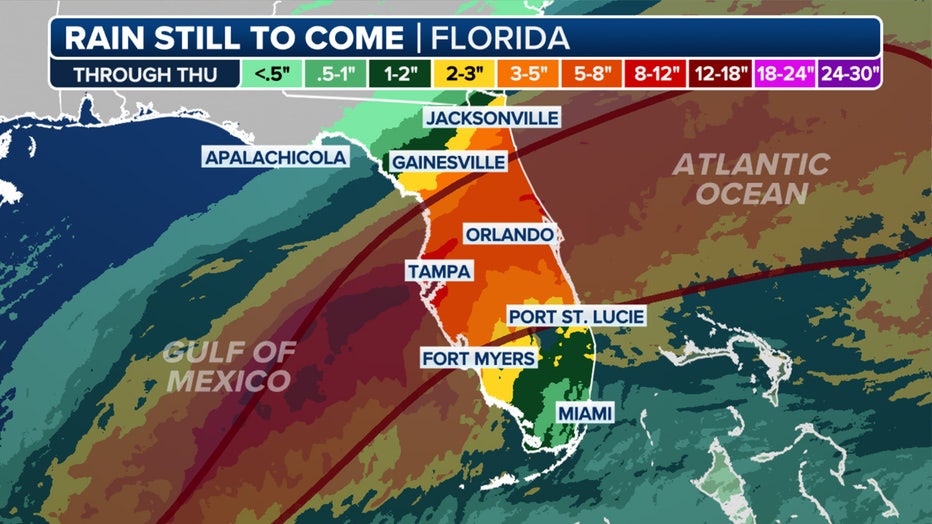
The rainfall forecast for Florida. (FOX Weather)
Here's everything you need to know about Hurricane Milton, including its location, projected path and watches/warnings in effect.
Track of Hurricane Milton: What's the latest with the storm?
Hurricane Milton is located about 500 miles southwest of Tampa and has maximum sustained winds of 180 mph, making it a strong Category 5 hurricane on the Saffir-Simpson Hurricane Wind Scale.
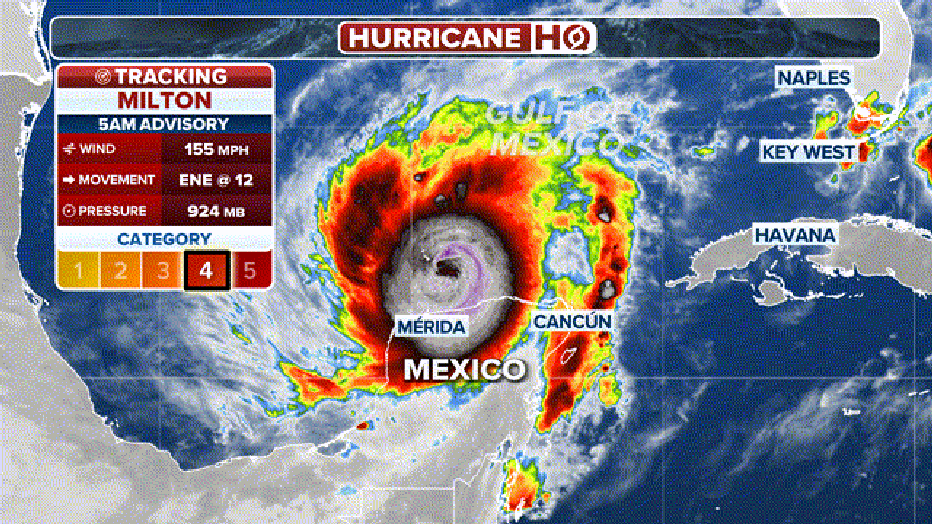
Current info on Hurricane Milton. (FOX Weather)
Milton is moving off to the east-northeast at 12 mph.
Path of Hurricane Milton 2024: What's the forecast?
The National Hurricane Center said Hurricane Milton should make a turn to the east and then northeast on Tuesday and Wednesday.
When will Hurricane Milton make landfall?
On that forecast track, Hurricane Milton is expected to move near or just north of Mexico's Yucatan Peninsula on Tuesday, then cross the eastern Gulf of Mexico and approach the west coast of the Florida Peninsula by Wednesday.
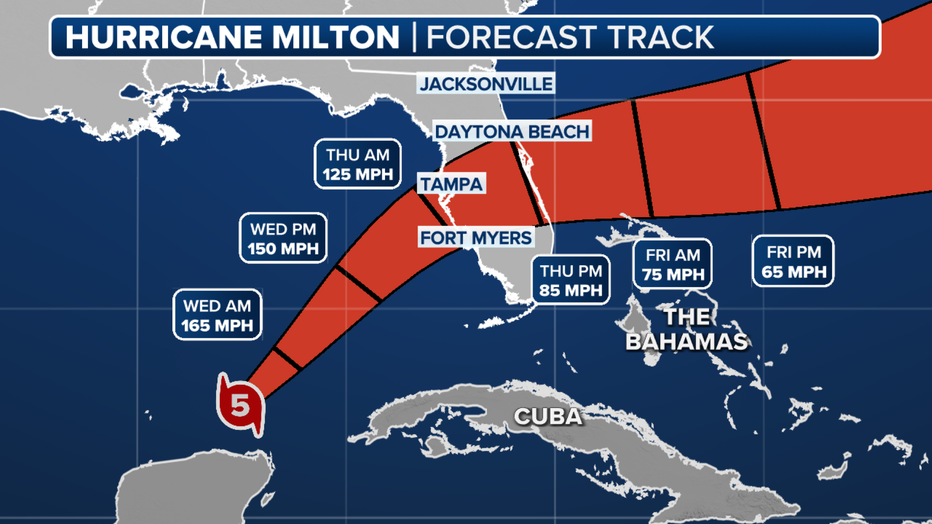
Credit: FOX Weather
Milton continues to be a monster storm and near record-breaking hurricane. According to the FOX Forecast Center, the hurricane has the second-lowest pressure on record in the Gulf of Mexico and the lowest pressure in the Atlantic since 2005.
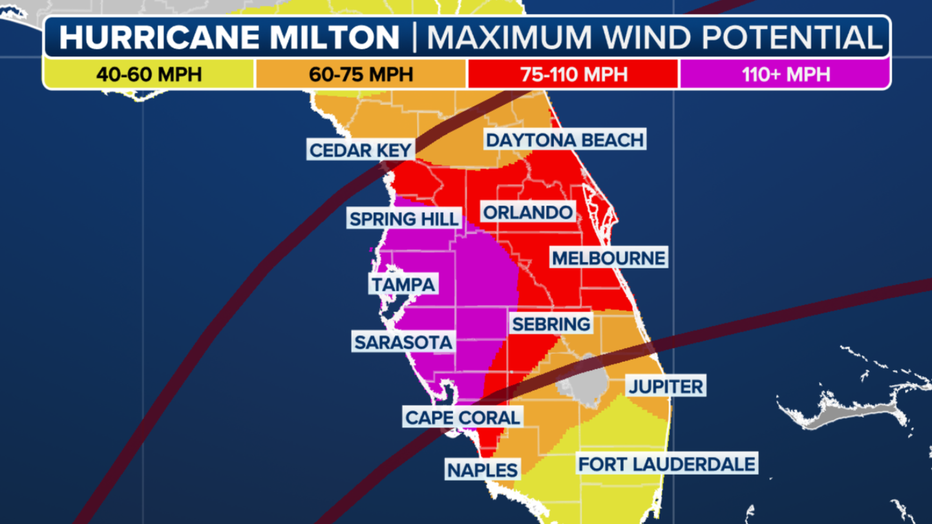
Credit: FOX Weather
At 180 mph, Milton is the strongest Atlantic hurricane in 5 years since Hurricane Dorian in 2019. Milton is also tied for the fourth-strongest storm since record keeping began. Hurricane Allen with 190 mph winds holds the record for the strongest Atlantic hurricane.
Is Hurricane Milton going to hit Orlando?
The first alerts were posted along Florida’s Gulf Coast early Monday morning, and those have since expanded to include more areas of Central Florida, including the Orlando area.
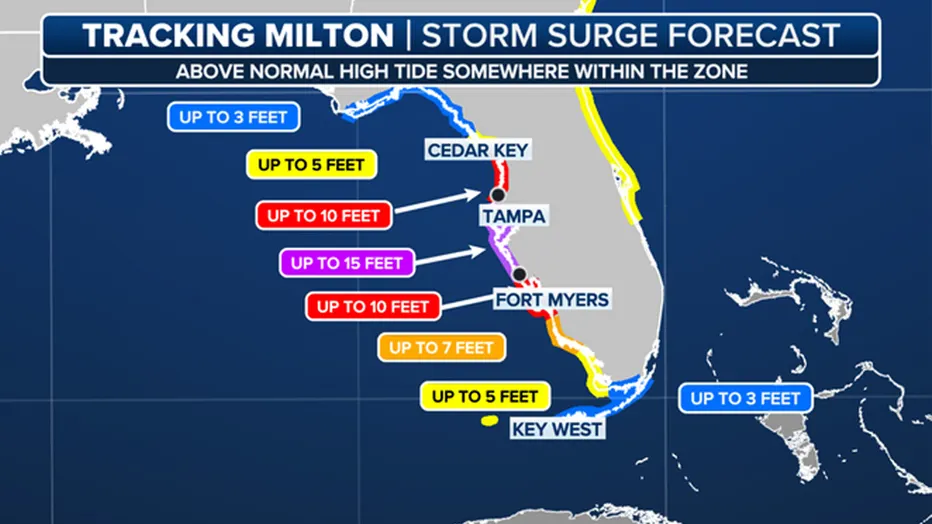
This graphic shows the storm surge forecast in Florida due to Hurricane Milton. (FOX Weather)
As Hurricane Milton approached, Storm Surge Warnings were issued for the Gulf Coast of Florida from Flamingo to the Suwannee River, including Charlotte Harbor and Tampa Bay.
Where are watches and warnings in effect?
The current storm surge forecast for Tampa Bay is up to 15 feet if the peak surge coincides with high tide. This is notably higher than during Helene, when Tampa Bay saw 7-8 feet of storm surge.

This graphic shows storm surge alerts in Florida due to Hurricane Milton. (FOX Weather)
Charlotte Harbor is expected to see a storm surge of 6-10 feet, while Bonita Beach could see a surge of 4-7 feet.
A Hurricane Warning has been issued for the west coast of Florida from Bonita Beach northward to the mouth of the Suwannee River, including Tampa Bay.
A Tropical Storm Warning has been issued for the west coast of Florida south of Bonita Beach to Flamingo, including Lake Okeechobee, and north of the mouth of the Suwannee River northward and westward to Indian Pass.
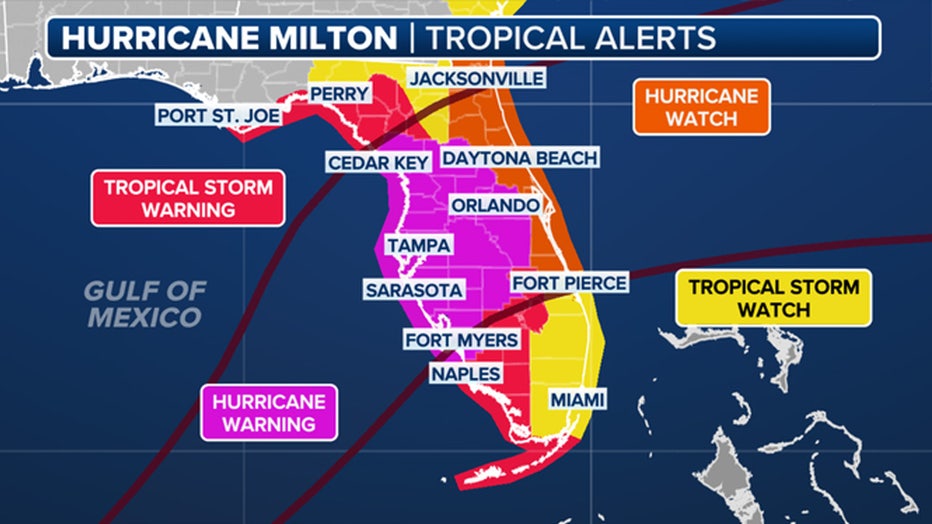
This graphic shows the various tropical alerts in effect in Florida due to Hurricane Milton. (FOX Weather)
A Tropical Storm Warning has also been issued for all of the Florida Keys, including the Dry Tortugas and Florida Bay. A Storm Surge Watch has been issued for the U.S. east coast from Sebastian Inlet Florida to Edisto Beach South Carolina, including the St. Johns River.
A Hurricane Watch has been issued along the east coast of the Florida Peninsula from the St. Lucie/Indian River County Line northward to the mouth of the St. Marys River.
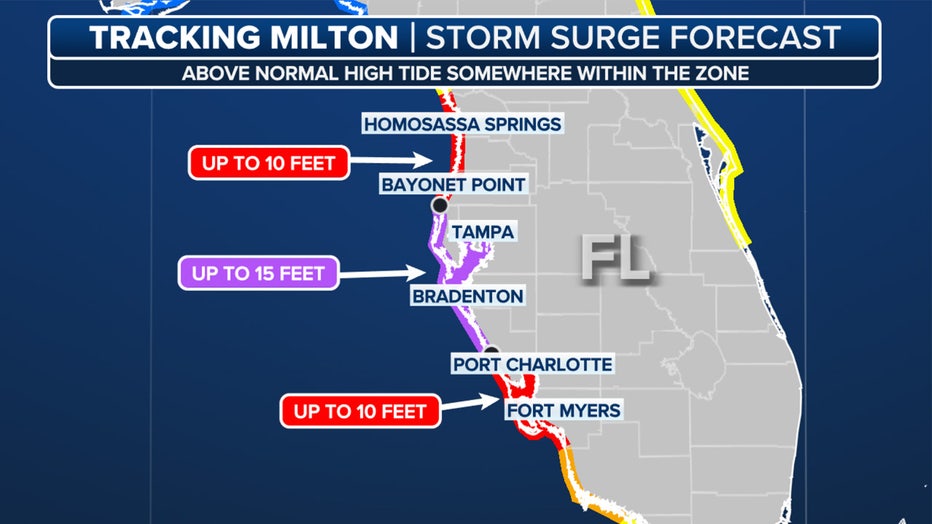
This graphic shows the storm surge forecast from Hurricane Milton in Florida. (FOX Weather)
A Tropical Storm Watch has been issued along the east coast of the Florida Peninsula south of the St. Lucie/Indian River County Line southward to Flamingo.
A Tropical Storm Watch has also been issued along the coast of Georgia and South Carolina from north of the mouth of the St. Marys River to South Santee River, South Carolina.
When to prepare for Milton
The situation is becoming more dire in Florida, with state and local officials warning residents that the time to prepare for the life-threatening storm is running out.
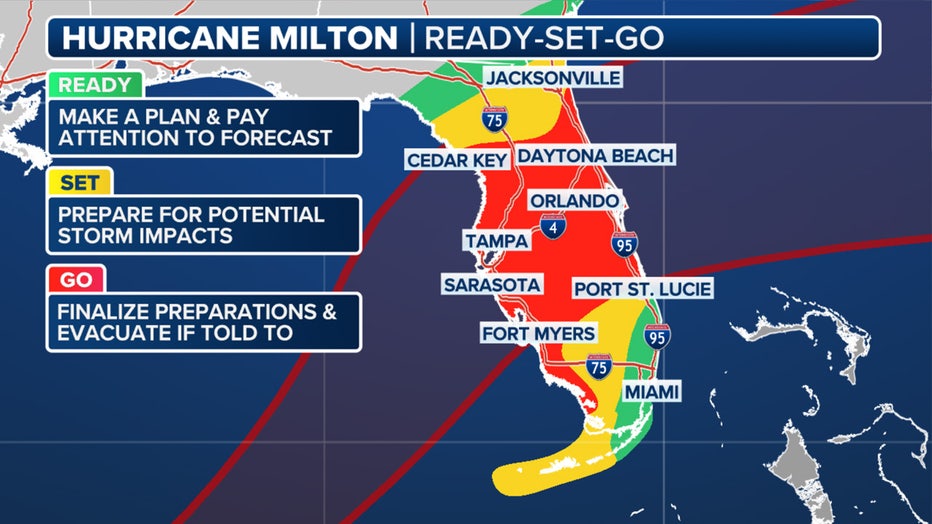
Tracking potential impacts from Milton. (FOX Weather)
They say people near the coast or living in low-lying areas need to get out before the storm approaches and brings with it a potentially deadly storm surge that could reach up to 15 feet in some spots, including Tampa Bay.
Hurricane categories
What is a Category 1 hurricane?
A hurricane with maximum sustained winds of 74-95 mph is considered to be a Category 1 cyclone on the Saffir-Simpson Hurricane Wind Scale.
A Category 1 storm is the weakest of all hurricanes but is stronger than a tropical storm.
What is a Category 2 hurricane?
A hurricane with maximum sustained winds of 96-110 mph is considered to be a Category 2 cyclone on the Saffir-Simpson Hurricane Wind Scale.
A Category 2 storm is stronger than a Category 1 and is just one status below what is considered to be a major hurricane.
What is a Category 3 hurricane?
A hurricane with maximum sustained winds of 111-129 mph is considered to be a Category 3 cyclone on the Saffir-Simpson Hurricane Wind Scale.
Once a hurricane strengthens into a Category 3 storm, it is considered to be a major hurricane.
What is a Category 4 hurricane?
A hurricane with maximum sustained winds of 130-156 mph is considered to be a Category 4 cyclone on the Saffir-Simpson Hurricane Wind Scale.
A Category 4 cyclone is considered to be a major hurricane and is only one class below a Category 5.
What is a Category 5 hurricane?
A hurricane with maximum sustained winds of at least 157 mph is considered to be a Category 5 cyclone on the Saffir-Simpson Hurricane Wind Scale.
A Category 5 is the strongest a hurricane can get on the scale, as there is not a Category 6 rating.
When does hurricane season end?
The Atlantic hurricane season runs from June to November. August, September and October are considered to be the peak months, with more than 85% of tropical systems forming during the three-month period.
FOX Weather helped contribute to this report.

